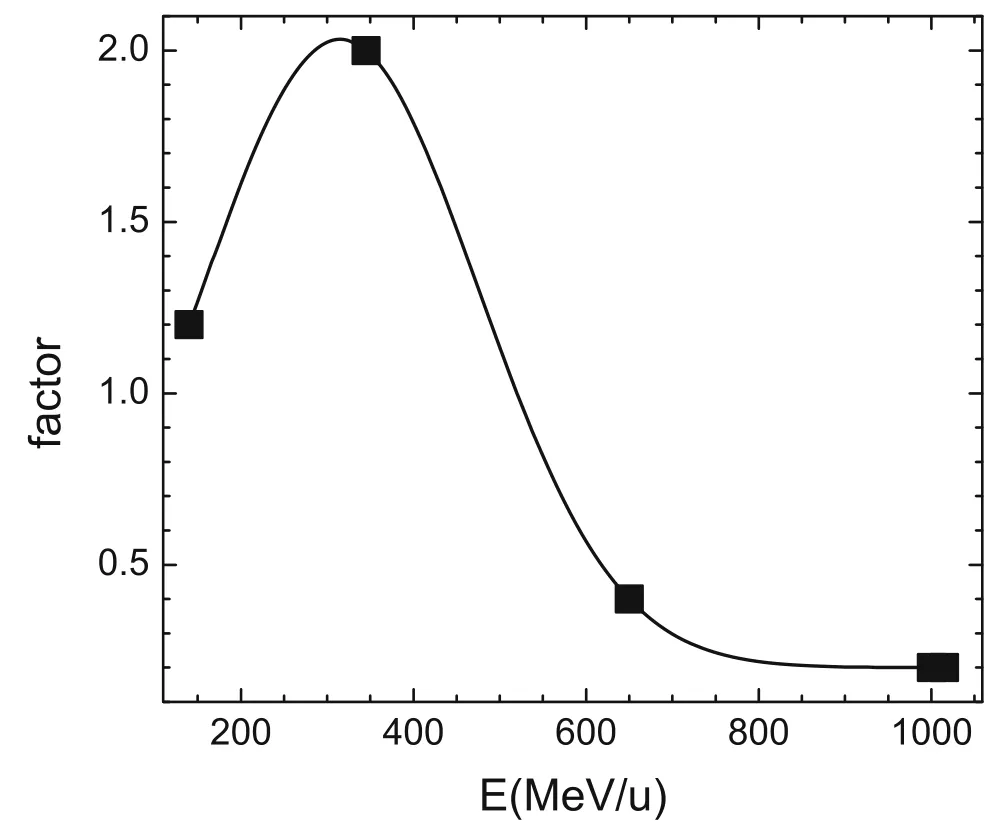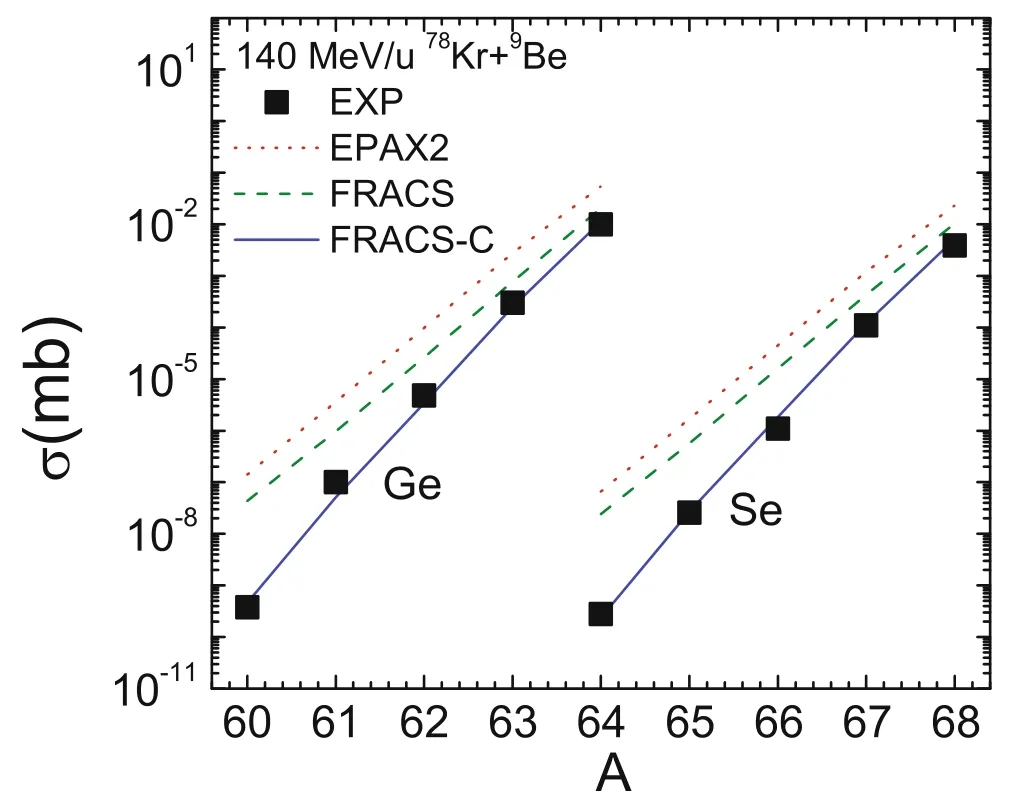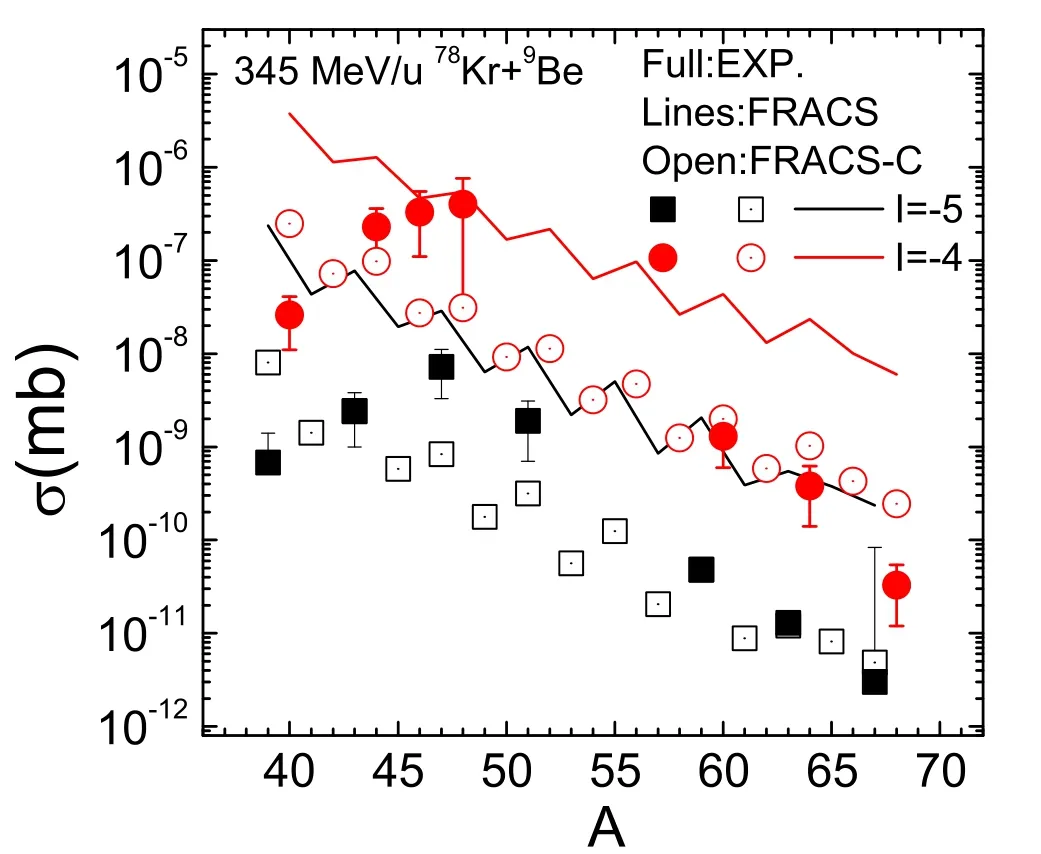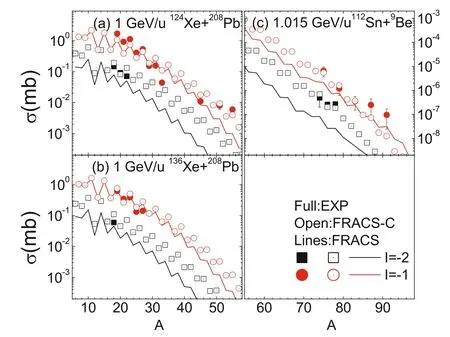Improved FRACS parameterizations for cross sections of isotopes near the proton drip line in projectile fragmentation reactions
2018-06-27YiDanSongHuiLingWeiChunWangMaJianHuaChen
Yi-Dan Song•Hui-Ling Wei•Chun-Wang Ma,2•Jian-Hua Chen
1 Introduction
It has been predicted that more than 8000 nuclides should be bounded,which have lifetimes longer than 1 μs[1–4].Most of these predicted nuclides are radioactive,and those with greatest asymmetry form the boundaries of the nuclides chart.Isotopes near the boundaries of the nuclides chart have attracted significant attention from both theoretical and experimental scientists as their properties remain unclear.Within the intermediate mass range,the study of isotopes near the proton drip line is very attractive,because radioactive nuclear beam(RNB)facilities have opened new research opportunities.Some exotic phenomena have been illustrated in proton-rich isotopes,such as the proton skin,proton halo,core deformation[5,6],and(β-)delayed one or two proton emissions[7–12].At present,the new generation of RNB facilities will extend the research to the more extremely asymmetric isotopes near the drip line region[13–16].Improved techniques also provide the new opportunities to learn about their properties in greater detail.The production probability,i.e.,cross section,is one of the most important physical quantities to study proton-rich nuclides in reactions while the production low rates make them difficult to measure.In experiments,it is important to be able to predict the yields or cross sections for proton-rich isotopes,which are not wellexplained in the existing methods.Many methods have been proposed to predict isotopic yields based on empirical formulas[17–19].Recently,Mei proposed the FRACS parameterizations[20]based on ideas from the EPAX parameterizations[21–23]by incorporating an extra term that depends on the incident energy.These parameterizations predict significantly better results compared with those from the existing models.
Though many advantages have been illustrated,the FRACS parameterizations are currently not the best option for predicting the presence of proton-rich isotopes,especially for those near the proton drip line.The main reasons are that the neutron-rich projectile nuclei,as well as the neutron-rich fragments,have been elaborately treated.However,the discussion for the proton-rich fragments(with neutron excess I≡N-Z<-1)has been omitted.In this article,the FRACS parameterizations are improved by re-adjusting the parameters for proton-rich isotopes,which we call the FRACS-C parameters,and we show that the parameters predict more accurate cross sections for isotopes near the proton drip lines.This article is organized as follows.Methods are described in Sect.2.The results are presented and discussed in Sect.3.A summary is presented in Sect.4.
2 Methods
Readers are referred to the original description of the FRACS parameterizations[20].In this article,we would like to introduce the most important portion related to the modifications applied to the original description.Three parts have been included in the FRACS parameterizations to predict the cross section of an isotope in projectile fragmentation reactions,i.e.,the mass yield,isobaric(charge)distribution,and odd–even staggering.The cross section for an isotope is described by Ref.[20],

where Y(A)is the mass yield and Y(Zprob-Z)represents the corresponding isobaric distribution. ΔOES(A,Z)is adopted to deal with odd–even staggering.The isobaric distribution is assumed to have a Gaussian distribution,with the remaining nuclear generation being related to the statistical evaporation from excited pre-fragments.The isobaric distribution of fragments with a given mass number A is borrowed from the EPAX parameterizations[21–23],

where Zprobis the most probable charge,n is a normalization factor,and R is the width parameter.In FRACS,ideas from the EPAX3 parameterizations have been borrowed[23],which allowed improved predictions for proton-rich isotopes.The projectile asymmetry is also corrected by introducingandterms,and so on.Extra exponent parameters Upand a transition point Zexp(A)are introduced for the proton-rich isotopes.Efforts have been also expended to overcome the disadvantages of the EPAX3 parameterizations,in which the dependence on incident energy was not considered[23].In the following results,it is shown that the FRACS parameterizations are still not sufficient for predicting the presence of proton-rich isotope of large asymmetry.To overcome this disadvantage of FRACS,the Zexpterm,which is the only term that affects the very proton-rich isotopes,should be adjusted.The Zexpreads as:

where R is a parameter to describe the width isobaric distribution,

where riis parameters,which are the same for the symmetric and asymmetric projectile nuclei.R0is different for the proton-rich projectile()and neutron-rich projectile(),respectively.For a proton-rich projectile,reads:

In Eq.(3),l1,l2,and the width parameter R are fixed by fitting a large amount of experimental data in the present FRACS.l2is the parameter to adjust the mass of isotope.The relevant parameter to adjustis r7.Thus,l1and r7should be the key parameters to improve the FRACS for the protonrich isotopes.As the description in Ref.[20],r7adjusts the width of the quasi-Gaussian shape of the isotopic distribution,and l1tunes the transition point where the quasi-Gaussian shape turns into an exponential decay,respectively(more parameters are used together inFRACS)[20].With a series of experimental results being investigated(as the following results in Sect.3),r7and l1are refitted for the proton-rich isotopes near the proton drip line,which are listed in Table 1 and shown in Fig.1.With the decreasing I,the isospin dependence of the proton-rich isotope is also not well considered.An extra term is introduced to describe the dependence of the cross section on the asymmetry of very proton-rich isotopes with I<-2:


Table 1 r7and l1values re fitted for proton-rich isotopes in the FRACS-C parameterizations

Fig.1 Correlation between l1(solid symbols)and E.A fit of the l1-E correlation to a Gaussian function is denoted by the solid line
The fitting result(see Fig.1)to the correlation between l1and E shows that it obeys a Gaussian function,which reads

3 Results and discussion
In this section,the predictions for the proton-rich isotopes by FRACS-C will be compared to the EPAX2 and FRACS methods.The measured cross sections for Ge(Z=32)and Se(Z=34)isotopes in the 140 MeV/u78Kr+9Be reaction[24]are plotted in Fig.2.The predictions from the EPAX2[22],FRACS[20],and FRACS-C parameterizations are compared to the measured data.The FRACS parameterizations show improved predictions for these isotopes with I ranging from-4 to 0,although the measured results are overestimated.By adopting the new fitted parameters and the extra term(given in Table 1),the FRACS-C can predict the measured cross sections quite well.
More measured isotopes in projectile fragmentation reactions will be tested with the FRACS-C parameterizations.In Fig.3,measured isotopes with I=-4 and-5 in the 345 MeV/u78Kr+9Be[11]are plotted together with predictions from the FRACS and FRACS-C parameterizations.One can see that the FRACS parameterizations significantly overestimate the measured results,while the results by the FRACS-C parameterizations show better agreement with the measured data compared to the FRACS parameterizations.

Fig.2(Color online)The measured cross sections(solid symbols)for the Ge and Se isotopes in the 140 MeV/u78Kr+9Be reaction[24],together with the predictions from EPAX2(dotted lines),FRACS(dashed lines),and FRACS-C (solid lines)parameterizations

Fig.3(Color online)The measured cross sections(solid symbols)for the Z=22-28 isotopes in the 345 MeV/u78Kr+9Be reaction[11]together with predictions from the FRACS(lines)and FRACS-C (open symbols)parameterizations
The cross sections of very proton-rich isotopes with Z=21-28 and I≥-6 in the 650 MeV/u58Ni+9Be reaction have been reported[25].The cross sections of these measured isotopes are shown in Fig.4,where the predicted results by FRACS and FRACS-C parameterizations are compared.For the I=0,1,and 2 nuclides,FRACS can reproduce the measured results well,while the FRACS tends to underestimate the measured results as the nuclide becomes more proton rich.The FRACS-C parameterizations reproduce the results for I≥0 and I<0 isotopes,even when I=-6.

Fig.4(Color online)Cross sections for the measured isotopes with Z=21-28(solid symbols)in the 650 MeV/u58Ni+9Be reaction[25].The predicted results by FRACS(lines)and FRACS-C (open symbols)are also plotted
The cross sections of the I=-1 and-2 nuclides have been measured in the 1.0 GeV/u124Xe+Pb[26]and136Xe+Pb,and 1.015 GeV/u112Sn+Be[27]reactions.The measured and predicted cross sections by FRACS and FRACS-C parameterizations are compared in Fig.5.One can see that,in the three reactions,the FRACS predictions agree with the measured data for the I=-1 nuclide,while the results for the I=-2 nuclide are underestimated.The FRACS-C parameterizations improve the prediction quality and reproduce the cross sections well for both the I=-1 and-2 nuclides.

Fig.5(Color online)The measured cross sections for the I=-2 and-1 isotopes(solid symbols)in the reactions of:(a)1.0 GeV/u124Xe+Pb[26],(b)1.0 GeV/u136Xe+Pb[26],and(c)1.015 GeV/u112Sn+Be[27].The predicted results by FRACS(lines)and FRACS-C (open symbols)are compared to the measured data
It has been claimed that the FRACS parameterizations are more appropriate for reactions with incident energy higher than 140 MeV/u because the parameters are fitted for the series of reactions with higher energy.In this article,we have investigated the reaction systems with intermediate(Ni+Be)to the heavy ones(Xe+Pb)masses with incident energy above 140 MeV/u.It is shown that the FRACS-C parameterizations improve the quality of the FRACS parameterizations for proton-rich isotopes and reproduce the measured results quite well.To quantitatively estimate the deviation factors for the predictions,an A-factor technique is adopted to show the deviation between the predicted and measured results in this work.The A-factor is defined as[28]

whereshould be the statistical error of the predicted cross section by the FRACS-C parameterizations.Statistical error has been ignored in this work since it could not be calculated by FRACS-C .The A-factor is independent and invariant with respect to exchange of the experimental and calculated cross sections.A prediction will be more accurate for smaller A-factor values.The predicted A-factor results using the FRACS and FRACS-C parameterizations are shown in Fig.6.It is easy to see that the values of the A-factor for the FRACS-C parameterizations,in general smaller than 0.3,are quite smaller than those for the FRACS parameterizations.

Fig.6(Color online)A-factors for the predicted cross sections of nuclides in different reactions by the FRACS(solid symbols)and FRACSC(open symbols)parameterizations.The A-factor results are calculated based on the I value of the isotope
The improved FRACS-C parameterizations for FRACS make it more suitable for cross-sectional predictions regarding proton-rich isotopes near the drip line area,which ful fills the urgent requirement for experimental designation of rare nuclei in projectile fragmentation reactions.
4 Summary
The FRACS parameterizations have been improved,which we call FRACS-C ,and have been used to predict the cross sections for isotopes produced in projectile fragmentation reactions.The parameters(r7and l1in FRACS)used to determine the cross sections of proton-rich isotopes have been re-adjusted,and an extra term is also introduced to better reproduce the cross sections for proton-rich isotopes.By analyzing the measured cross sections of proton-rich isotopes produced in a series of reactions,including the 140 and 345 MeV/u78Kr+9Be,650 MeV/u58Ni+9Be,1 GeV/u124,136Xe+Pb,1.015 GeV/u112Sn+9Be reactions,it is shown that FRACS-C can better reproduce the measured cross sections of nuclides with I=-6,which is considerably close to the proton drip line of intermediate mass nuclides.
AcknowledgementsWe thank Dr.B.Mei for sending us his well written code for FRACS,which cuts the time for us to finish this work.
1.X.W.Xia,Y.Lim,P.W.Zhao et al.,The limits of the nuclear landscape explored by the relativistic continuum Hartree–Bogoliubov theory.Atomic Data Nucl.Data Tables 121–122,1(2018).https://doi.org/10.1016/j.adt.2017.09.001
2.H.Wang,G.Audi,F.G.Kondevetal.,The AME2016 atomicmass evaluation(II).Tables,graphs and references.Chin.Phys.C 41,030003(2017).https://doi.org/10.1088/1674-1137/41/3/030003
3.R.Utama,J.Piekarewicz,Validating neural-network refinements of nuclear mass models.Phys.Rev.C 97,014306(2018).https://doi.org/10.1103/PhysRevC.97.014306
4.N.Wang,M.Liu,X.Wu et al.,Surface diffuseness correction in global mass formula.Phys.Lett.B 734,215(2014).https://doi.org/10.1016/j.physletb.2014.05.049.For WS4 mass table see http://www.imqmd.com/mass/WS4.txt
5.G.Sawhney,R.K.Gupta,M.K.Sharma,Importance of deformations in dynamical evolution of proton-halo nuclei.Acta Phys.Polon.B 47,959(2016).https://doi.org/10.5506/APhysPolB.47.959
6.D.Q.Fang,W.Guo,C.W.Ma et al.,Examining the exotic structure of the proton-rich nucleus Al-23.Phys.Rev.C 76,031601(2007).https://doi.org/10.1103/PhysRevC.76.031601
7.L.J.Sun,C.J.Lin,X.X.Xu et al.,Experimental Study of betadelayed proton emission of Ca-(36,37).Chin.Phys.Lett.32,012301(2015).https://doi.org/10.1088/0256-307X/32/1/012301
8.Y.G.Ma,D.Q.Fang,X.Y.Sun et al.,Different mechanism of two-proton emission from proton-rich nuclei Al-23 and Mg-22.Phys.Lett.B 743,306(2015).https://doi.org/10.1016/j.physletb.2015.02.066
9.X.X.Xu,L.J.Sun,C.J.Lin et al.,Observation of Beta-delayed two-proton emission in the decay of Si-22.Phys.Lett.B 766,312(2017).https://doi.org/10.1016/j.physletb.2017.01.028
10.L.J.Sun,X.X.Xu,D.Q.Fang et al.,Beta-decay study of the Tz=-2 proton-rich nucleus Mg-20.Phys.Rev.C 95,014314(2017).https://doi.org/10.1103/PhysRevC.95.014314
11.B.Blank,T.Goigoux,P.Ascher et al.,New neutron-deficient isotopes from Kr-78 fragmentation.Phys.Rev.C 93,061301(R)(2016).https://doi.org/10.1103/PhysRevC.93.061301
12.T.Goigoux,P.Ascher,B.Blank et al.,Two-proton radioactivity of Kr-67.Phys.Rev.Lett.117,162501(2016).https://doi.org/10.1103/PhysRevLett.117.162501
13.T.Kubo,In- flight RI beam separator BigRIPS at RIKEN and elsewhere in Japan.NIM B204,97(2003).https://doi.org/10.1016/S0168-583X(02)01896-7
14.B.-H.Sun,J.-W.Zhao,X.-H.Zhang et al.,Towards the full realization of the RIBLL2 beam line at the HIRFL-CSR complex.Sci.Bull.63,78(2018).https://doi.org/10.1016/j.scib.2017.12.005
15.J.W.Xia,W.L.Zhan,B.W.Wei et al.,The heavy ion coolerstorage-ring project(HIRFL-CSR)at Lanzhou.NIM A488,11(2002).https://doi.org/10.1016/S0168-9002(02)00475-8
16.M.Hausmann,A.M.Aaron,A.M.Amthor et al.,Design of the advanced rare isotope separator ARIS at FRIB.NIM B317,349(2013).https://doi.org/10.1016/j.nimb.2013.06.042
17.C.W.Ma,J.L.Xu,An empirical formula for isotopic yield in Fe+p spallation reactions.J.Phys.G:Nucl.Part.Phys.44,125101(2017).https://doi.org/10.1088/1361-6471/aa90e6
18.M.Yu,H.-L.Wei,Y.-D.Song,C.-W.Ma,Experimental determination of one-and two-neutron separation energies for neutron-rich copper isotopes.Chin.Phys.C 41,094001(2017).https://doi.org/10.1088/1674-1137/41/9/094001
19.M.B.Tsang,W.G.Lynch,W.A.Friedman et al.,Fragmentation cross sections and binding energies of neutron-rich nuclei.Phys.Rev.C 76,041302(R)(2007).https://doi.org/10.1103/PhysRevC.76.041302
20.B.Mei,Improved empirical parameterization for projectile fragmentation cross sections.Phys.Rev.C 95,034608(2017).https://doi.org/10.1103/PhysRevC.95.034608
21.K.Sümmerer,B.Blank,Modified empirical parametrization of fragmentation cross sections.Phys.Rev.C 61,034607(2000).https://doi.org/10.1103/PhysRevC.61.034607
22.K.Sümmerer,Improved empirical parametrization of fragmentation cross sections.Phys.Rev.C 86,014601(2012).https://doi.org/10.1103/PhysRevC.86.014601
23.K.Sümmerer,Erratum:improved empirical parametrization of fragmentation cross sections[Phys.Rev.C 86,014601(2012)].Phys.Rev.C 87,039903(2013).https://doi.org/10.1103/Phys RevC.87.039903
24.A.Stolz,T.Baumann,N.H.Frank et al.,First observation of Ge-60 and Se-64.Phys.Lett.B 627,32(2005).https://doi.org/10.1016/j.physletb.2005.08.130
25.B.Blank,S.Andriamonje,R.D.Moral et al.,Production cross sections and the particle stability of proton-rich nuclei from Ni-58 fragmentation.Phys.Rev.C 50,2398(1994).https://doi.org/10.1103/PhysRevC.50.2398
26.D.Henzlova,K.-H.Schmidt,M.V.Ricciardi et al.,Experimental investigation of the residues produced in the 136Xe+Pb and 124Xe+Pb fragmentation reactions at 1A GeV.Phys.Rev.C 78,044616(2008).https://doi.org/10.1103/PhysRevC.78.044616
27.A.Stolz,T.Faestermann,J.Friese et al.,Projectile fragmentation of Sn-112 at Elab=1A GeV.Phys.Rev.C 65,064603(2002).https://doi.org/10.1103/PhysRevC.65.064603
28.S.K.Sharma,B.Kamys,F.Goldenbaum et al.,Ranking and validation of spallation models for isotopic production cross sections of heavy residua.Eur.Phys.J.A 53,150(2017).https://doi.org/10.1140/epja/i2017-12334-2
杂志排行
Nuclear Science and Techniques的其它文章
- Gamma irradiation-induced effects on the properties of TiO2 on fluorine-doped tin oxide prepared by atomic layer deposition
- Preliminary analysis of tritium fuel cycle in Z-pinch-driven fusion– fission hybrid reactor
- Investigation of high-temperature-resistant rhenium–boron neutron shields by experimental studies and Monte Carlo simulations
- Monte Carlo simulation of incident electrons passing through thin metal layer
- Annual effective dose values from137Cs activity concentrations in soils of Manisa,Turkey
- Investigation of SPECT/CT cardiac imaging using Geant4
